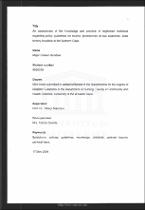| dc.contributor.advisor | Nikodem, Cheryl | |
| dc.contributor.author | de Maar, Major Colleen | |
| dc.date.accessioned | 2022-09-02T10:43:37Z | |
| dc.date.available | 2022-09-02T10:43:37Z | |
| dc.date.issued | 2004 | |
| dc.identifier.uri | http://hdl.handle.net/11394/9286 | |
| dc.description | Magister Curationis - MCur | en_US |
| dc.description.abstract | An episiotomy is the surgical incision of the perineum. As far is known, was
this procedure was done as early as 17 41. Sir Fielding Quid, was the first
person to describe this procedure in his "Treatise of Midwifery in Three parts",
as an aid to assist with difficult deliveries. The implementation of this
intervention is a worldwide phenomenon and has been recorded during the
19th century as one of the most common surgical procedures in the clinical
practice. The World Health Organisation has taken a clear stand against
routine episiotomies and recommend that episiotomy rates should be around
10% and no more than 20%. There are no clear guidelines in the literature
available that give true and valid indications for the performance of an
episiotomy.
Aim
The aim was to determine whether the two tertiary academic institutions in the
Western Cape have policies and guidelines available regarding the
performance of episiotomies by registered midwives and to determine the
knowledge and practice of registered midwives regarding these policies and
Methodology
The researcher made use of a descriptive survey to explore the issue whether
guidelines exist regarding episiotomies and whether midwives are aware
about these guidelines. Structured questionnaires were used to gain
information from the registered midwives. The researcher also made use of
documents (birth register) and in-depth interviews (unit managers).
Results
The findings of the study concluded that midwives are aware of the latest
evidence that episiotomies are not done routinely even though no evidence of
existing policies could be allocated in any of the two wards. The finding
further shown that the current guidelines are not based on evidence.
Midwives do not directly rely on guidelines in the wards (non available), but
an inference is made that the midwives obtain access via secondary sources
such as obstetricians. Midwives feels competent to do episiotomies but would
like to be updated on knowledge regarding procedures and agree that skills
updates are important. They are not aware of how to gain access to evidence
based literature such as systematic reviews.
Conclusions
There is an urgent need to inform the regulatory professional body to review
their regulations as the current regulation as it stands promotes more harm
than good. Similarly is there a need to inform the national, provincial and local
government I institutions, that if they publish guidelines they need to ensure
that these guidelines are based on the latest evidence where possible. It is
further important that policies be available to all members of staff to update
them self with current information. In-service updates on evidence. | en_US |
| dc.language.iso | en | en_US |
| dc.publisher | University of the Western Cape | en_US |
| dc.title | An assessment of the knowledge and practice of registered midwives regarding policy guidelines for routine episiotomies at two academic, state tertiary hospitals in the Western Cape. | en_US |
| dc.rights.holder | University of the Western Cape | en_US |

